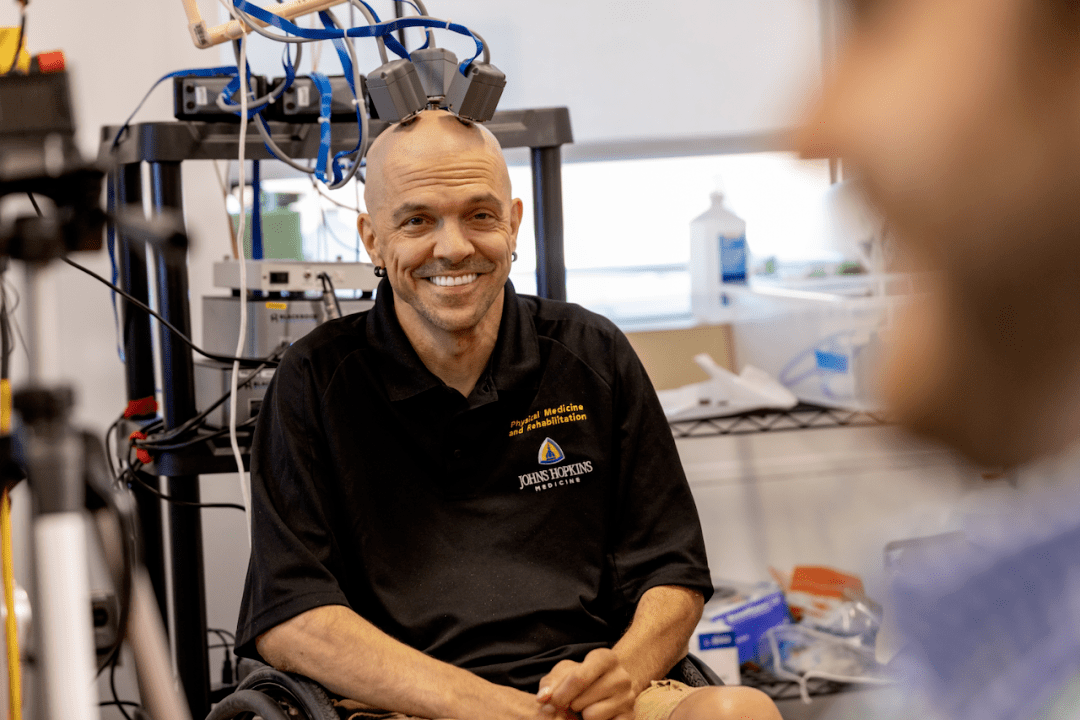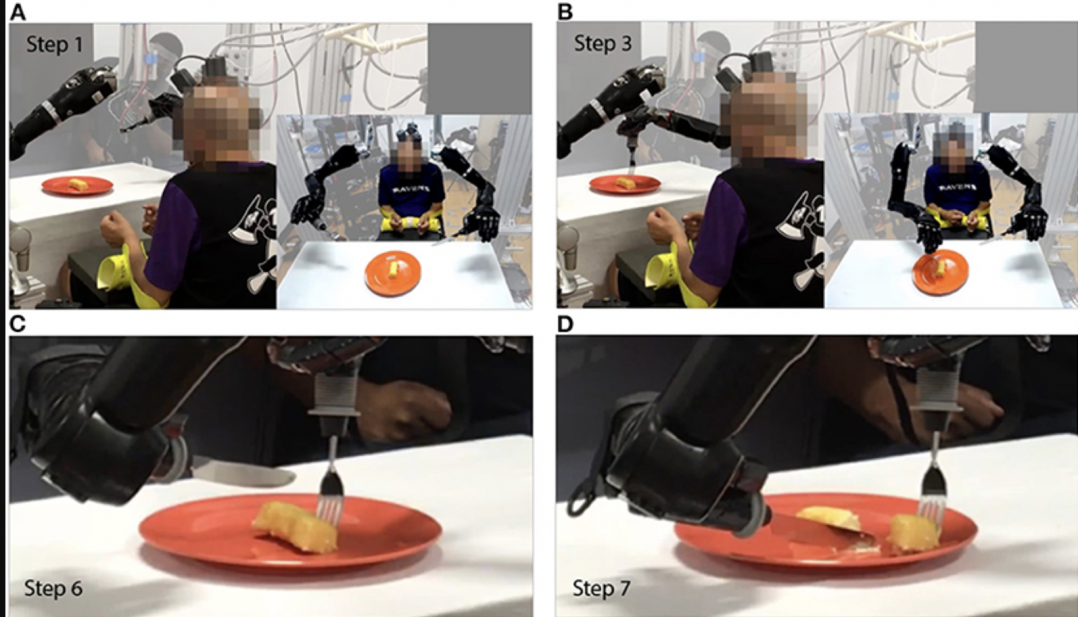The world's first example!After 30 years of paralysis, he could "eat independently"
Author:Medical community Time:2022.07.10

"You want the robotic arm‘ cut cake ’, what you think may be‘ eat cake ’”
Written article | Ling Jun
Source | "Medical Community" public account
A person who has been paralyzed for 30 years, with the help of "ideas" and robotic arm, has gained the ability to eat independently.
His head was implanted with electrodes on both sides, and the line on the top of his head was connected to the analysis table. The two black robotic arms were ready above a plate of cakes. In less than 90 seconds, he used the "idea" to command the robotic arm, move the knife fork, cut the appropriate size, and send the food to his mouth.
This is the world's first successful bilateral implantation of the human body test. On June 28, researchers from Johns Hopkins University released this strong role in journal Frontiers in Neurorobotics.
Video source: "Neuroscopy Study on the Frontier"
Eat the cake with "thought"
"Up and down", "left and right", "rotate with clockwise" .......... If you want to eat a piece of cake on the table, you need at least 12 physical freedom. The more complicated exercise behavior must reach at least 34.
But Chmielewski is a patient with spinal cord injury. An unexpected surfing accident in his teens made his wrist and fingers only retain the weak sports function. Until 2019, 49 -year -old Chmielewski participated in the research project called "Revolutionary Poor (RP)" by Johns Hopkins.

In the closed -loop system that combines artificial intelligence, robotics and brain interfaces, the six mung bean -sized micro -electrode array is implanted with the Chmielewski brain. Through 9 months of study, he has established "mild activities" and machinery on hand Map of "complex activity" of the arm.
The finger "Zhang, He" corresponds to the "up and down" of the robotic arm, and the wrist "bending and stretching" slightly corresponds to "Chao, away from the cake". One by one. "Professor Li Xiaojian, an expert in the field of brain -machine interface and the senior engineer of the Shenzhen Advanced Institute of China, told the" medical community ".
The "transmission" in the test includes the extraction and analysis of the brain signal, and then transported to the terminal device -robotic arm.

In this trial, patients can control 4 physical freedom in both hands. The remaining eight degrees of freedom is also the highlight of this experiment, which is completed by a method called "collaborative sharing control mode".
It can be understood as "ideas". This is a kind of human -machine connection that is established in advance. No longer uses limbs, and the brain directly issues abstract instructions to the external equipment, such as cutting cakes and sending them into the mouth.
The reason why the two are needed, not all through "ideas", because patients still need some basic "control". With the game as a metaphor, you can implement the "one -click combination operation" through some special keys, but some basic forward and backward details can still choose to control it yourself.
Researchers say that this method can ensure that the patient's mental activity needs to the greatest extent while the series of movements are completed. In the next plan, they want to increase the patient's tactile feedback and let them feel the operation of the robotic arm.

"Although the task displayed this time does not use the electrical stimulus function, the early results have shown that the electrical stimulating body dermatological layer specific point can provide 'touch feelings'." Professor Li Xiaojian said, "In the future, patients do not need to judge machinery through their eyes to judge mechanical machinery Whether the arms get the tableware, like your own hand, the touch information can be sent directly to the brain, I believe it can be achieved. "
"As long as there are electric wires above the head, it is impossible to land clinical"
For people with disabilities, the test is considered a big step in "restoring physical independence and autonomy". Further imagine a future scene. Whether it is health or serious illness, humans can control the control of most smart devices through the brain interface and use "ideas" to completely liberate the body's labor. Can it become a reality?
"From the current technology, you can use it to drink water with a glass of water, typing virtual keyboards to typing, and synthetic voice, and complete some 2D or simple 3D operations, but more complex and more refined multi -finger collaborative campaigns, such as weaving one, such as weaving one Sweaters are earlier. "Li Xiaojian told the" medical community ".
"Collecting the brain signal is only the first step of the Long March. The difficulty is how the collected signal establishes a causal relationship with the behavior to be done. This is a process of nerve learning." Professor Li Xiaojian explained that the more complex and fine operation, the more complex and finely operated, and the more refined operation, the decoding of the neuron signal, the decoding The more difficult to filter the invalid information and feedback into effective mapping.
Taking the control robotic arm as an example, the brain interface is mainly collected by a small part of the motion cortex, which is not the same neuron group as controlling autologous hands. "It's like there is no" jump "on the computer keyboard, only space." Professor Li Xiaojian said, "You want the robotic arm to cut cakes', and what you start to think about is just 'eating cakes'. The relationship between ideas and actual action needs to be Find an optimal solution and re -establish it through training. "
Caption: Chmielewsk is practicing how to control the corresponding action through ideas

In the end, it can stabilize how much effective information is resolved and transformed into smooth movements, which is also one of the key to the implementation of the brain interface. In this case, only 12 exercises with freedom have been trained for nearly one year. Professor Li Xiaojian further evaluated:
This time is the science and technology level of the bionic robotic arm, not in the "brain interface" itself. The patient has a total of 6 electrodes in a total of 6 electrodes to obtain the 4 freedom signals of the hand instructions. All rely on the automatic control module that can execute abstract instructions.
On the other hand, Professor Li Xiaojian told the "medical community" that as long as the "wire" grew above the head, connecting the computer through the wire, the brain interface cannot become a real clinical medical device, and can only stay in the laboratory.
It is reported that this time it is the Neuroport electrode array developed by BlackRock Neurotech in the United States. It is currently the only cortex spinning nerve sensor approved by the US -brain -brain interface research.
Professor Li Xiaojian said that the brain -machine interface device for medical devices must be wireless communication, but at present, he wants to rely on the large -scale transceiver and send neuros signals by the implanted wireless brain interface in the whole.
"It is necessary to reduce the volume of implants as much as possible, but also obtain high -throughput neural signals from multiple brain areas to achieve wireless energy supply and transmission high -throughput data. Still need to be resolved. "Professor Li Xiaojian said.
Eat a piece of cake in 90 seconds? This step is to be taken
In fact, the concept of brain interface can be traced back to the middle of the last century. Early in the early days, it was mostly research on mechanisms of related disciplines. It was limited by the difficulty of approval of clinical trials and the use of the human body.
The first is the issue of safety. Professor Li Xiaojian introduced, including the larger cranial wound, implant rejection reaction, and possible compression damage to brain cells.
Followed by "cost -effective". "Spending a lot of energy and financial resources to bear safety risks. Finally, you can only drink a glass of water and eat a piece of cake. You have to do it under the monitoring of the service staff. This is not a medical choice that will make in normal conditions." Professor Li Xiaojian said.
But after entering the 21st century, the box is gradually opening with the development of neuroscience, brain science, mechanical engineering, and clinical medicine.
From 2005 Americans Matthew Nagle became the first disabled person in the world to control robotics through implantation brain interfaces, to 2019 to complete the first domestic implanted brain machine interface clinical transformation research in Zhejiang University Medical College. The field field enters the acceleration period.
By 2020, Neuralink, a brain interface company of Musk's brain -machine interface company, implanted a small electrode, but only coin -sized devices into the pig's brain in a minimally invasive manner. Another milestone breakthrough.

In addition to the resilience of people with disabled disabled, another cutting -edge exploration of the brain interface is concentrated in the field of mental illness, including the treatment of depression and schizophrenia.
"Emotion, memory, cognition ... Different from the motion and somatosensory cortex located on the shallow brain. This type of function involves more brain areas, the implementation mechanism is less, and the decoding will be more complicated." Professor Li Xiaojian said.
From the turning water to the stream of streams, Professor Li Xiaojian told the "medical community", "Some people have doubts, and even the brain has not even thoroughly studied it, why start developing the brain's brain interface?"
"In addition to paralyzed patients with urgent use of brain interface technology, in fact, the imperfect brain research is largely attributed to the lack of deep, high -precision and long -term brain signal collection analysis." Professor Li Xiaojian said, " The functional performance of the human brain is too different from the experimental animal. It is not much meaningful to use animal experiments for a long time. "
In his opinion, this is also the significance of the brain interface in recent years. Eat a piece of cake in 90 seconds? Although it can be done very limited, this step is to take it out after all. It is reported that dozens of scientific research clinical research in the United States has conducted dozens of scientific research on implanted brain interfaces. The FDA in the United States has launched an application guide for implanted brain machine interface medical devices. With the launch of the "China Brain Plan", more and more local research has been developing in clinical development.
Starting from eating a piece of cake, perhaps a certain day is as described as a science fiction movie, and the brain interface will become a torrent in the medical field.
Expert Introduction
Li Xiaojian
The Shenzhen Academy of Sciences Shenzhen Advanced Technology Research Institute is a senior engineer, a doctoral supervisor. Doctoral Physics Institute of the Chinese Academy of Sciences has successively worked at Georgia Medical College and Northwestern University of the United States. The main research areas are high -performance brain -machine interfaces and brain -like engineering. It is the first to penetrate the broadband implanted brain -type brain interface technology chain in China and take the lead in developing neural regulation methods based on optical nanotechnology internationally. Published a number of important influence articles in topics such as biomedical engineering, neuroscience, and nanotechnology.

Want to get more hot special specials?
Is it enough for HPV vaccine to take a shot?
What is the difference between analog vaccine and MRNA vaccine?
The FDA of the United States announced the "new crown vaccine 1291 side effects". What is the truth?
"Medicine" hand information you want to see
The "Medical Special" column of the doctor's station has
- END -
Ji Shi Da Live | Safety Production Month ・ "I" is the first responsible person

June this year is the 21st national production safety month. In order to promote t...
Fuping County Meteorological Observatory lifted lightning yellow warning [Class III/heavier]
Fuxing County Meteorological Observatory lifted the thunderbolt warning signal at 06:53 on June 10, 2022.